The Legend of Zelda Preview
The next installment in Nintendo's highly regarded Zelda franchise is on its way to the GameCube. Find out everything we know about the game in this comprehensive hands-on preview.
Few games have caused as large an uproar in the gaming community as The Legend of Zelda for the GameCube has. When the game was first shown almost two years ago, the art style looked to be a continuation of that from the Zelda games for the Nintendo 64. But at last year's Space World show in Japan, Nintendo yanked the carpet out from underneath the entire industry by showing a completely new Zelda game, complete with some impressive cel-shaded graphics. Those who longed for a more serious, realistic-looking Zelda moaned, while others embraced the new look as a stroke of brilliance. Now that the press and fans have played the game, anger over the art style has been quelled, and the public's focus on the game has been turned toward Zelda's gameplay.
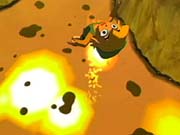
The Zelda franchise hasn't exactly followed a continuous plot throughout its history--it usually jumps all over the place from one installment to the next, often confusing those trying to map it and create one cohesive plot history. But it is known that this, the first Zelda for the GameCube, is set somewhere near the beginning of the series' storyline. What's known of the game's story is very basic at this point. After being kidnapped by a huge bird, Link must rescue his sister, Arill, from the clutches of a yet-unknown captor. So far there are no signs of the triforce, Princess Zelda, Hyrule, or Link's perpetual nemesis, Ganon. While the story remains rudimentary at this stage of the game, players have come to expect the unexpected from previous Zelda games, and there's little reason to believe that The Legend of Zelda for the GameCube will be any different. Already there are some interesting conspiracy theories flying around. If this Zelda is truly set near the beginning of the entire storyline, why wasn't Arill in previous Zelda games that were set later in time? Does Arill die, or is she really princess Zelda? We'll have to play to find out.
The Ocarina of Time established several staples of 3D gaming that are still borrowed by many other games today, the most prominent of which is the Z-lock. The targeting system has again returned for The Legend of Zelda, except you'll be using the L button instead. Once locked onto an enemy, you can make Link circle around it looking for the opportunistic time to jump in for a slash attack by pressing the B button. You can also cycle through nearby enemies by clicking the L button or make Link roll to avoid enemies by holding the analog stick to one side and pressing B. Holding down the A button and then releasing it will cause Link to perform an impressive spinning slash, while tapping it will cause him to perform a multitude of swipes and simple combos. As in previous Zelda games, there are plenty of hidden items to find by breaking pots and giving the grass a good thrashing with Link's sword.
Another innovation from The Ocarina of Time is the automatic jump, and that gameplay element has also returned for another go. Link can also hang from ledges and shimmy along them. This time around both the B and R buttons are context sensitive depending upon whether or not Link is in combat. The R button is reserved for defending with Link's shield, crouching, or pushing crates. Once in the crouched position, Link can also crawl on his belly. When not used for locking onto enemies, the B button is used for more simplistic tasks like talking to nonplayable characters, climbing onto boxes and other high objects, releasing Link from a rope he's swinging on, or picking up items.
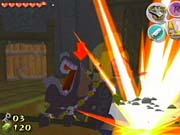
In fact, picking up items is very important to The Legend of Zelda's puzzles, because you now have the ability to pick up and use weapons dropped by fallen enemies. Many times the way to go may be boarded up, so you'll have to take out an enemy with a bigger sword and then use it to bust down the barrier. Other times enemies will drop a wooden staff that Link can then set on fire like a deku stick and use to light torches to solve puzzles.
Explore Vast Worlds
As you might expect, using special items is key in progressing through the game. So far just three special items have been revealed, including an updated version of the hookshot, a periscope, and a magical stone that Link wears around his neck. The hookshot is used to help Link reach out-of-the-way areas, and the periscope allows him to see things from a distance. Much like Navi, the fairy from The Ocarina of Time, the magical stone will occasionally supply Link with hints that he must access by pressing the Z button. Any of Link's items can be mapped to either the X or Y buttons for easy access. To use the hookshot, you tap the corresponding button once, and Link will begin to swing it around. Tapping the button a second time will then cause him to give it a toss. The interface provides ample access to Link's special items, but it falls a bit short of having three items mapped to the C buttons in the Nintendo 64 Zelda games.
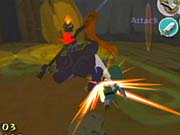
The directional pad is also put to good use--pressing up will bring up the map, pressing left will toggle a window display, and tapping right will cycle through Link's available items. If you press down on the directional pad, it will cause a map in the bottom right-hand corner to disappear to keep your view from being obstructed. Link's health is again measured in hearts. After defeating bosses, you're rewarded with new heart containers that increase Link's maximum health.
Five sections of The Legend of Zelda have been shown so far, with each having a primary gameplay focus. The Island of the Magical Beast is a stealth level where Link must infiltrate an island compound while avoiding searchlights. Link's ultimate goal is to seek out the characters operating the searchlights and take them out. To make the job easier, he can hide behind barrels and wait for the moblin guards to turn their backs before moving on. The camera can be manually adjusted using the C stick, and it's essential to look around corners to find hidden guards. If Link's caught, he'll be placed in jail and will have to break out via a network of crawl spaces. And with the game's sharp enemy AI, it's not easy. Nintendo has stated that the same amount of work went into the AI for the more common enemies as for the boss characters, and it certainly shows in their reactions to the slightest bit of movement or sound.
Dragon Mountain takes place in a network of caves, where Link must use brute force to defeat enemies and then pick up their weapons to solve simple puzzles. Island of Beginning features a great number of wandering nonplayer characters who ask Link to perform a variety of tasks, such as capturing a pig, for rewards. Battle with the Boss is a boss fight set in a lava pit against a huge crablike creature with enormous claws. Link must use his hookshot to poke the beast in its eye. After the boss has taken a few optical shots, its head will come down, and Link can then go after the eye with his sword.
Vast Ocean is a sailing stage in which Link must cruise around a bay in a small ship, collecting the rupees that are perched on top of barrels. If Link cruises over the wrong barrels, they will explode and send him careening into the water. He will then have to get back into the boat, and you'll have to press the R button to set sail once again. During the minigame you have three minutes to collect as many rupees as possible. To do this, you must watch an arrow that denotes the direction of the wind. Sailing with the wind will allow you to build up speed with the boat to reach some of the rupees that are perched above the water's surface. Based upon statements made by Nintendo, sailing will have a large impact on the game as a whole. Perhaps the ship is Link's means of travel since his horse, Epona, shows up much later in the series' timeline.
The Legend of Zelda also includes an option to play the game cooperatively using the Game Boy Advance. To do so, a Game Boy Advance must be connected to the GameCube via a link cable. Once this is done, an icon depicting the handheld can be selected like any other item in Link's inventory. The player playing on the Game Boy Advance only sees a schematic on the screen with crude icons depicting both his and Link's locations on the map. But he can also see his location on the television screen in the form of a square. While playing on the Game Boy Advance, you can drop bombs in the GameCube version of the game that will blow up both enemies and Link alike. Therefore, it's important to keep in control. The player using the Game Boy Advance can also alert Link to danger.
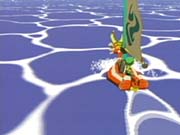
A Living, Breathing Cartoon
Without a doubt, The Legend of Zelda is the closest thing to a 3D cartoon ever created. Many would attribute this to its cel-shaded art design, but it's really more a product of its exquisite animation. In fact, you'd be hard pressed to find better animation in any other game. The facial animation for moblins alone is enough to raise a few eyebrows, but the smaller details are what really set it apart. The tassels hanging off their spears will react to every object they come into contact with and will realistically drag along the ground when the spear is held low. The walking and reactive animations are just as sharp and match some of the best work seen out of studios like Disney. Many have complained about Link's new appearance, but his large face and eyes were designed intentionally so that he could convey more emotion than in games past. In the areas we were treated to, Link demonstrated fear, jubilation, excitement, and a multitude of other moods during the game's many real-time cinemas.
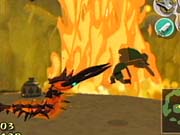
While the animation demonstrates an amazing attention to detail, the graphics engine is no slouch either. Graphical tricks are pulled out of the bag left and right, with some being so subtle that you'd miss them if you weren't looking. One level takes place inside a volcano, and the entire screen is filled with a faint heat blur. Another seaside area has volumetric fog and mist blowing across the entire scene that is so convincing you can almost smell the salt water. Transparencies, reflections, and environmental mapping are all par for the course and are pulled off without a hitch in frame rates despite the fact that single blades of polygonal grass are being displayed along with miles of terrain.
But perhaps what's most impressive is how the game manages to maintain its cartoony art design on a consistent basis. When enemies are defeated they dissolve into puffs of purple and black swirls of smoke. When Link runs, smaller swirls can be seen dancing about his feet. When Link's sword comes into contact with an enemy's weapon, exaggerated sparks and starbursts abound. But the game's "wow factor" increases dramatically when the cel-shaded graphics are mixed with multicolored lighting. Perhaps it's the contrast of combining the surreal with reality, but regardless of the cause, it has to be seen in motion to be appreciated. Self-shadowing adorns every object in the game, making the visual presentation all the more convincing.
The game's biggest graphical issue is its camera. It can get confused at times and leave you with a poor view of the proceedings. It can be adjusted with the C stick, or you can go into a first-person view by pressing the Z button, but in the middle of a boss fight, a finicky camera should be the last of your worries. This is likely on Nintendo's list of problems to address, so it shouldn't be an issue by the time the game's ready to ship. The camera does do some interesting things that were not seen in the Zelda games for the Nintendo 64. For instance, if you throw the hookshot and it makes contact with an object, the camera will switch to show it wrapping around the object.
The Legend of Zelda maintains its air of anonymity by not supplying voices for any of the characters in the game. This is done intentionally to leave the experience more open-ended and tailored for each player. Instead, text bubbles are displayed to facilitate communication. The sound effects for clanging swords are as convincing as ever, while Link's battle cries are representative of his young stature. As you might expect, the music in the game is of an orchestral nature with blaring brass and crashing cymbals, though no familiar songs were heard in the areas we were allowed to play. The game includes Dolby Pro Logic II support, and the results are already encouraging--positional audio is already in effect, and the audio clarity is quite good.
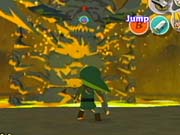
The Legend of Zelda is one beautiful game that plays very well, but so far it lacks that innovative gameplay punch that prior games in the series included. Perhaps there are gameplay elements that haven't been revealed yet, but as it stands, the game stays very true to the franchise's heritage while providing a few tweaks. Of course, for a franchise that has consistently delivered, this is by no means a bad thing. Fans of the Zelda franchise or fans of video games in general should be very excited about Link's first outing on the GameCube. Nintendo is currently projecting The Legend of Zelda for release around the turn of the year, though savvy gamers likely know that this release date will almost undoubtedly be pushed back. We'll have more on this highly anticipated game when Nintendo makes it available.
Got a news tip or want to contact us directly? Email news@gamespot.com
Join the conversation